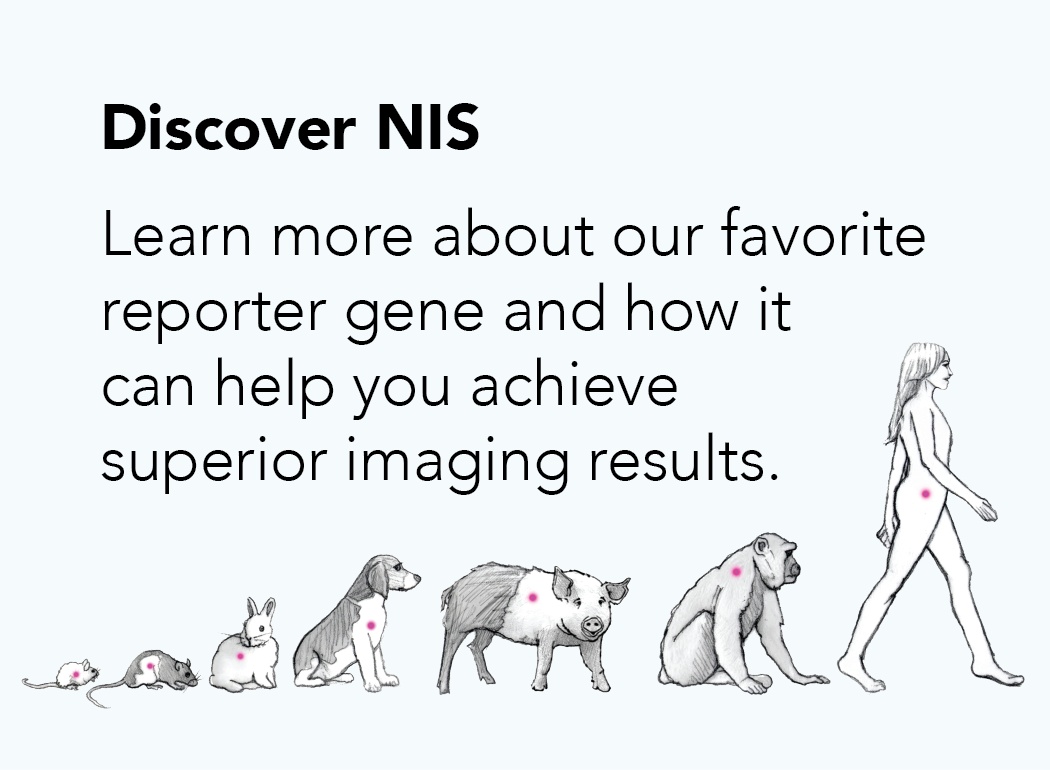Nalm6 (Leukemia)
Description
Nalm6 is a B cell precursor leukemia cell line initiated from an adolescent male. It is a CD24-positive xenograft model of acute lymphoblastic leukemia.
Our Nalm6 reporter cell lines can be easily tracked and quantitated in vivo, making them great tools for studying the mechanisms of tumor growth and metastasis, as well as evaluating the effects of various drugs or therapies in animals. Nalm6 cells are great models for B-cell differentiation, CNS infiltration and metastasis, as well as pre-B leukemias [1-3]. As a CD19+ cell line, traceable Nalm6 cells are ideal for testing novel CAR T cell or other immunotherapies for efficacy in vivo [4]. Our Nalm6 cells are available with a variety of different reporters, including the human sodium iodide symporter (hNIS), firefly luciferase (Fluc), and enhanced green fluorescent protein (eGFP). Dual reporter Nalm6 cell lines are available to facilitate multimodal imaging.
In order to ensure high, constitutive expression of the reporter proteins, our cell lines are generated by lentivirus transduction. The lentivirus vectors used for these transductions are self-inactivating (SIN) vectors in which the viral enhancer and promoter has been deleted. This increases the biosafety of the lentiviruses by preventing mobilization of replication competent viruses.
- Hartmann, TN, al, Human B cells express the orphan chemokine receptor CRAM-A/B in a maturation-stage-dependent and CCL5-modulated manner. Immunology. 2008
- Kinjyo, I, al, Leukemia-derived exosomes and cytokines pave the way for entry into the brain. J Leukoc Biol. 2019.
- Mei, al, PRMT5-mediated H4R3sme2 Confers Cell Differentiation in Pediatric B-cell Precursor Acute Lymphoblastic Leukemia. Clin Cancer Res. 2019.
- Liu, X, al, Improved anti-leukemia activities of adoptively transferred T cells expressing bispecific T-cell engager in mice. Blood Cancer J. 2016.
Usage Information
Nalm6 cells are suitable for in vitro and in vivo experimentation. The cells will form tumors and spontaneous metastases in immunocompromised mice. Depending on the route of inoculation (see below), implanted Nalm6 cells can metastasize to the bone marrow, liver, spleen, and lymph nodes.
The following chart provides some examples of Nalm6 cells used for tumor formation and studies.
| Route of Implantation | Mice | Tumor/Metastases | References |
| Intravenous | SCID-beige | Bone marrow, liver, spleen, lymph nodes, periodontal region | Santos et al. (2009) Nature Med 15: 338-344. |
| Intravenous | NSG | Live, bone marrow | Barrett, et al. (2011) Blood 118: e112-e117. |
| Subcutaneous | SCID-beige | Subcutaneous tumor | Santos et al. (2009) Nature Med 15: 338-344. |
Stable reporter cell lines
Our Nalm6 reporter cell lines can be tracked in vivo, making them great tools for studying the mechanisms of tumor growth and metastasis, as well as evaluating the effects of various drugs or therapies in animals. Our Nalm6 cells are available with a variety of different reporters, including the human sodium iodide symporter (hNIS), firefly luciferase (Fluc), and enhanced green fluorescent protein (eGFP). Dual reporter Nalm6 cell lines are available to facilitate multimodal imaging.
In order to ensure high, constitutive expression of the reporter proteins, our cell lines are generated by lentivirus transduction. The lentivirus vectors used for these transductions are self-inactivating (SIN) vectors in which the viral enhancer and promoter has been deleted. This increases the biosafety of the lentiviruses by preventing mobilization of replication competent viruses (Miyoshi et al., J Virol. 1998).

